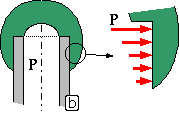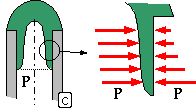
Tube end problem
The benefits of delaying problem completion until after ideation is complete are demonstrated by the problem : "How to prevent fluid escaping from the end of the tube ?"
We keep the problem as broad as possible by not being more specific, and brainstorm the following candidate solutions :
- manually close an upstream valve
- screw cap over end
- weld flange and bolt cover to it
- balance a book on the end
- crimp the tube (eg. squeeze it flat)
- explosive ditto
- liquid trap
- rely on surface tension
- stick your thumb in the end
- push cork or squash ball into end
- the reverse - stick end into cork
- blob of Blu.Tack or chewing gum
- drain contents then no more can escape
- clothes peg to squeeze end shut
- automatic ball-valve like toilet cistern
- slip a toy balloon over end
- reduce pressure in tube
- weld up the end
- increase the pressure outside the end
- melt the end & fuse into sealing blob
- freeze fluid
- tie a knot in the tube
- surround end with magnet
- gladwrap, bandaid or other sticky tape
- ignite any escaping fluid
- insert a flat soccer ball in the tube then inflate it
- turn tube upside down and stick it into ground
- jet another fluid into end
- weighted piston inside tube
- set up standing pressure wave
- cover end with a pile of earth
- electrostatic precipitator (smoke)
- &c &c &c
You don't need a degree in quantum physics to generate ideas like these - but good general knowledge clearly helps.
Having generated the bank of solution candidates, we would then complete the problem by defining a set of appropriate constraints and criteria involving typical attributes as follows :
- fluid : air/ water/ steam/ liquid chlorine/ blood/ conc sulphuric acid/ person's breath/ sewage/ &c
- hazard : toxic/ benign/ environmentally sensitive/ &c
- tube : steel/ glass/ artery/ plastic/ paper/ earthenware/ wooden/ &c
- size : 2m dia Goldfields pipeline/ capillary/ 40mm dia car radiator hose/ garden sprinkler/ 500mm dia air-conditioning duct/ &c
- effectiveness : absolutely leakproof/ just prevent some escaping/ the odd drip doesn't matter/ &c
- pressure : 1 mm H2O/ high pressure (10 MPa)/ water mains/ sound pressure amplitude/ &c
- closure : releasable/ permanent/ manually controllable (bath tap)/ only for 5 minutes/ automatic/ &c
- cost : of no consequence (emergency)/ quantity production/ &c
- &c &c &c
The complete problem might be one of the following, for example :
- a flexible armoured high pressure 20mm dia steam hose
- a 1500mm dia asbestos stormwater culvert during a flood
- a 2mm dia stainless pipe with liquid chlorine adjacent to a schoolroom
- a hypodermic needle containing HIV positive blood
- a fractured underground pipe conveying avgas under a busy air terminal
- a windmill-filled water pipe to a stock trough way out on the range
- - and so on, the combinations are infinite.
How many of the above solutions would we have dreamed up if the complete problem had been known beforehand ? Precious few !
Of course many if not most of the solutions are completely impractical for a particular problem scenario, but the point is that once solution candidates have been generated it is relatively easy to criticise in order to weed out the crazy candidates - and, as we have noted before, crazy candidates often trigger, or can be transformed into, practical solutions. If you don't try for novel competitive solutions by ideating in this manner, then you're heading for the same fate as Jane !
Besides, what at first glance may appear crazy, could turn out to be perfectly viable after practicalising.  Let's demonstrate by following the design process a little further here. We shall try to practicalise candidate #16 for example, the toy balloon, on the presumption that the scenario is not extreme, ie. tube diameter around 20mm, non-hazardous liquid at a pressure P well below domestic water pressure, and so on.
Let's demonstrate by following the design process a little further here. We shall try to practicalise candidate #16 for example, the toy balloon, on the presumption that the scenario is not extreme, ie. tube diameter around 20mm, non-hazardous liquid at a pressure P well below domestic water pressure, and so on.
Assuming that the neck can be forced over the tube end, the situation might appear as in sketch a here. The balloon's grip around the tube - determined by elastic properties and initial stretching - manifests itself as a contact pressure between neck and tube exterior surface. Provided the fluid pressure is not too great, its tendency to blow the balloon off the end may be resisted by friction corresponding to the pressure over the contact area.
Depending upon the relative magnitude of contact and fluid pressures, fluid might find its way through the contact region between neck and tube, thus destroying friction and causing immediate blow-off.

Recognising this, the basic idea might be modified as in sketch b by replacing the balloon by a more robust but still flexible cover, the idea being to increase the contact pressure. The cover could be moulded from a high density polymer.
The enlargement indicates fluid pressure on the cover if a leakage path should develop - the fluid pressure decreases from P at the interior to zero at the outside of the leakage path. The fluid pressure tends to bend the cover's wall (like a beam) away from the tube, with a corresponding reduction in equilibrating friction and in cover retention capabilities.
In an effort to improve retention, the arrangement of sketch c is proposed, the external cover being replaced by a flexible internal bung.  Clearly the higher the fluid pressure, the higher will be the contact pressure and friction, as the fluid pressure tends to push the flexible wall of the bung against the tube's interior surface.
Clearly the higher the fluid pressure, the higher will be the contact pressure and friction, as the fluid pressure tends to push the flexible wall of the bung against the tube's interior surface.
If a leakage path should develop, as indicated by the enlargement, then the fluid pressure outside the wall must be less than the full fluid pressure inside - the net tendency being to force the bung wall against the tube thereby closing off the path. Note the advantages of this arrangement compared to a solid bung or cork.
Practicalisation could continue with detailed mathematical modelling based on presumed pressure-deformation characteristics of the bung wall and tube, probable coefficient of friction, etc etc. The analysis would have to allow for the non-elastic behaviour of the plastic bung, the inevitability of manufacturing inaccuracies which could drastically affect frictional "grip", and other non-ideal behaviour.

Recognising that any mathematical model which avoided expensive complexity was not going to be very accurate, practicalising emphasis might switch to R&D. An artefact would therefore be manufactured, tested and modified until its service behaviour could be predicted with confidence. It may prove advisable eg. to incorporate grooves around the bung wall's exterior, sketch d, which in service would contain adhesive to enhance the bung's holding power.
We need not take this problem any further. It has demonstrated the advantages of ideating without preconceptions, without details and without criticism. There is plenty scope for detailed work later in the design process.
 Copyright 1999-2000 Douglas Wright,
doug@mech.uwa.edu.au
Copyright 1999-2000 Douglas Wright,
doug@mech.uwa.edu.au
last updated 10 Jan 1999
 Let's demonstrate by following the design process a little further here. We shall try to practicalise candidate #16 for example, the toy balloon, on the presumption that the scenario is not extreme, ie. tube diameter around 20mm, non-hazardous liquid at a pressure P well below domestic water pressure, and so on.
Let's demonstrate by following the design process a little further here. We shall try to practicalise candidate #16 for example, the toy balloon, on the presumption that the scenario is not extreme, ie. tube diameter around 20mm, non-hazardous liquid at a pressure P well below domestic water pressure, and so on.


 Clearly the higher the fluid pressure, the higher will be the contact pressure and friction, as the fluid pressure tends to push the flexible wall of the bung against the tube's interior surface.
Clearly the higher the fluid pressure, the higher will be the contact pressure and friction, as the fluid pressure tends to push the flexible wall of the bung against the tube's interior surface.
